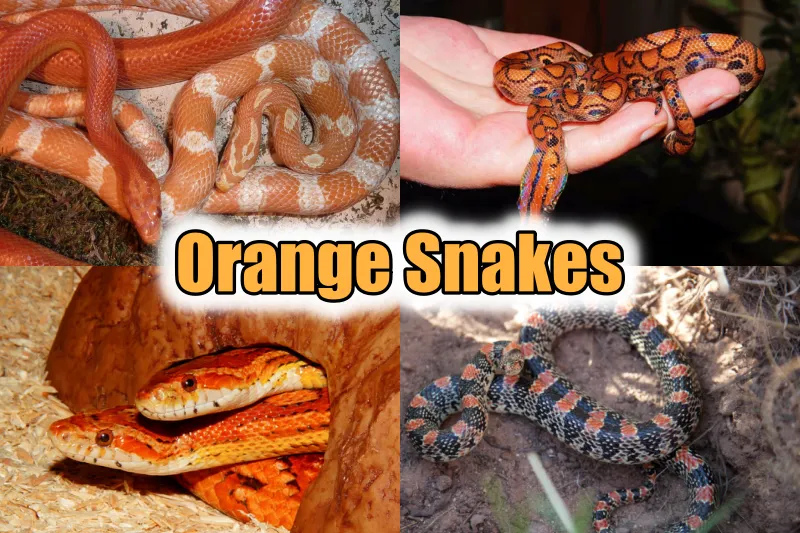For all you reptile enthusiasts out there, we are here with yet another thoughtfully curated list of 20 orange snakes you might or might not want to have as a pet.
These creatures, often misunderstood, comprise a whooping of 3,789 species, making these the second largest reptile group. This calls for being more aware of them. They have been divided into 30 families and several sub-families. Around 140 of them reside in Australia making it the snake-haven.
With the huge number comes an even greater variety, and today we are here with information about a fraction of them that come in the amazing and vibrant color – Orange. As you explore our list, you will find an array of both venomous and non-venomous orange snakes.
20 Orange Snakes and Their Native Environments
1) Long-nosed snake
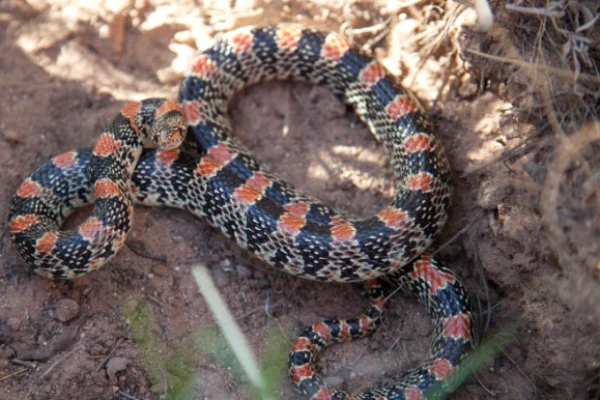
| Scientific Name | Rhinocheilus lecontei |
| Size | 22–32 in (max: 41 in) |
| Diet | They feed on lizards, amphibians, and sometimes the other smaller snakes, and rarely on rodents. |
| Location | Northern Mexico, Southwestern USA |
They are identified by their long, slightly upturned snout.
Their tricolor body is usually confused with that of a coral snake.
Their skin is mesmerizing, combining black and orangish-red on a yellow or cream-colored background.
They are introvert’s friends as they are shy and spend most of their time buried underground.
Non-venomous and generally harmless, they tend to release foul-smelling musk and blood from their cloaca as a defense mechanism.
2) Ring-necked snake
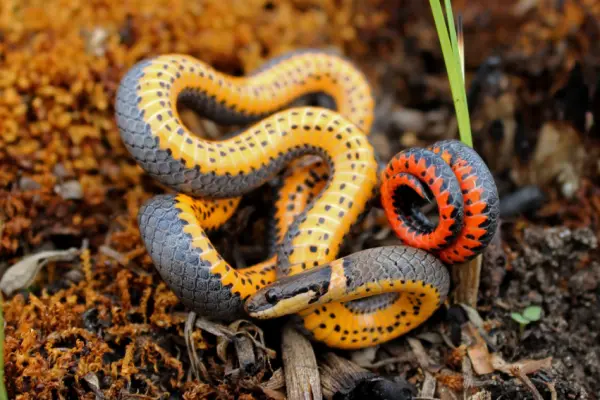
| Scientific Name | Diadophis punctatus |
| Size | 10-15 in |
| Diet | Primarily feed on salamanders, earthworms, and slugs but they do sometimes prey on lizards, frogs, and other small snakes. |
| Location | The United States and Mexico |
These beauties are commonly found in the states of the United States and its neighboring countries.
They are characterized by their distinct and eye-catching coloration which is a perfect blend of black, olive-green, or grey on the upper side and a bright shade of orange on the lower side.
Though they lack a true venom gland, they do have something called the – Duvernoy’s gland derived from the same tissue as the venom gland.
The secretions from the gland may not be fatal to humans but they have shown significant reduction in the defense ability of their prey.
They are the ambiverts of the snake species, as they usually keep things to themselves but are sometimes seen displaying social behavior.
3) Milksnake
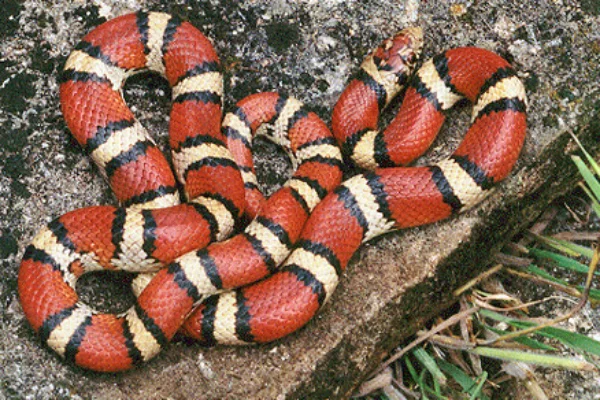
| Scientific Name | Lampropeltis triangulum |
| Size | 14-72 in |
| Diet | Young milk snakes eat crickets and other insects while the adult prey on small mammals, birds and their eggs, frogs and other snakes and their eggs |
| Location | North America and Mexico |
These harmless creatures have a strong preference for living in wooded areas that are close to wetland areas.
They can be very different sizes depending on the subspecies and the location.
They have a stunning pattern of alternating bands of orangish-red, black, and yellow running down their smooth scales, which run down their bodies.
They have such an uncanny resemblance to pygmy rattlers that people frequently get the two confused with one another.
4) Corn snake
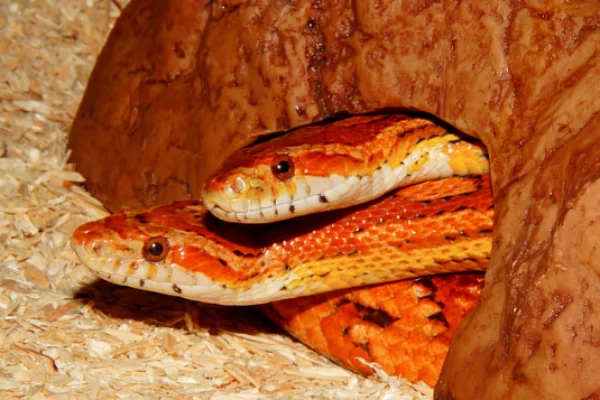
| Scientific Name | Pantherophis guttatus |
| Size | 24-71 in |
| Diet | Known to feed on small rodents, a few reptiles, and sometimes unguarded bird eggs too. |
| Location | Southeastern United States |
They are named so for their distinctive checkered pattern on their belly that resemble the kernels of variegated corn.
These intelligent creatures use the vibration of their tail as their defense mechanism.
They are often killed as a result of their resemblance to a copperhead, a venomous snake. Corn snake on the other hand is harmless and subdues their prey by constriction.
5) Pinewoods snake
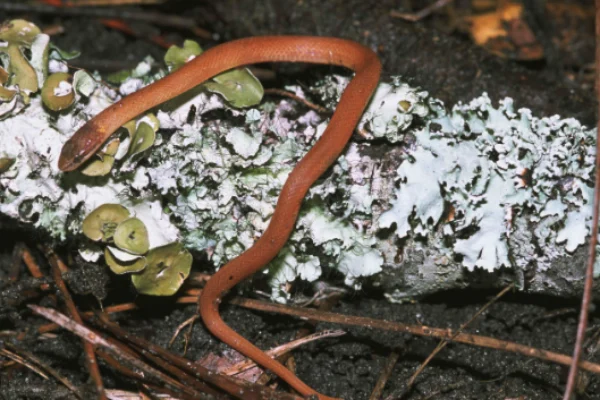
| Scientific Name | Rhadinaea flavilata |
| Size | 10-13 in |
| Diet | They prey on small amphibians and reptiles like lizards, salamanders, and frogs |
| Location | Southeastern United States |
One of the smallest snakes with a reddish-orange skin and a lighter stripe running down their center.
They are nocturnal and mildly venomous but not dangerous to humans.
They don’t usually bite when picked up but release a foul-smelling odor from their cloaca.
6) Red-bellied black snake
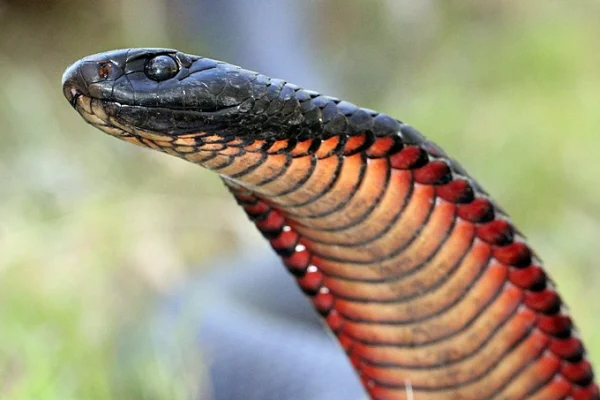
| Scientific Name | Pseudechis porphyriacus |
| Size | 25-50 in |
| Diet | Primarily consists of small amphibians and reptiles but they also eat smaller snakes of either the same or different species. |
| Location | Australia |
These long beautiful reptiles have glossy black upper skin and bright orange or red bellies.
Though venomous, they are not known to have caused any threats to humans. Although when bitten, their venom can cause significant illness but no deaths have been reported.
They are reported to be a least-concern species according to the International Union for Conservation of Nature, but industrialization around and in their habitat and decline in the population of rats have greatly affected the number.
7) Red diamond rattlesnake
| Scientific Name | Crotalus ruber |
| Size | 39-55 in |
| Diet | They prey on rabbits, ground squirrels, birds, lizards, and other snakes. |
| Location | United States and Mexico |
These venomous pit viper species are differentiated by their distinct reddish-orange color, which them their name.
Their head and body have a pinkish tan, giving them an orangish appearance.
These are known to be the least poisonous rattlesnakes. Nonetheless, a bite from them can be fatal if not treated on time.
8) Scarlet snake
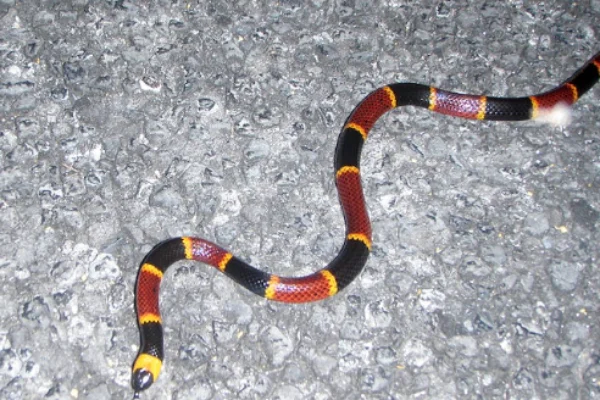
| Scientific Name | Cemophora coccinea |
| Size | 14-26 in |
| Diet | Lizards, small rodents, bird’s eggs, and sometimes smaller snakes. |
| Location | Southeastern United States |
Their dorsal side has a distinct pattern running down their skin consisting of alternating black, red, orange, white, or yellow blotches while their belly has a uniform gay or white color.
They are nocturnal and generally active during the summer months.
Like Pinewood snakes, they only release a foul-smelling odor on being picked up.
9) Western ground snake
| Scientific Name | Sonora semiannulata |
| Size | 8-19 in |
| Diet | They primarily feed on invertebrates such as spiders, scorpions, and insect larvae. |
| Location | Southwestern United States |
These small, harmless snakes are endemic to North America.
The color of their skin can vary widely depending on the geographic location.
They can be orange, red, or brown with black banding while their underside is usually white or gray.
They are nocturnal and secretive, but these are common throughout their species.
10) Arizona Mountain Kingsnake

| Scientific Name | Lampropeltis pyromelana |
| Size | 36 in |
| Diet | Lizards, rodents, and birds |
| Location | Arizona |
They belong to the same genus as the milk snake.
The pattern on their skin remains consistent with alternating bands of orange and cream with black borders.
They tend to spend their daytime living among rocks, logs, or anything swampy.
11) Gray-banded kingsnake
| Scientific Name | Lampropeltis alterna |
| Size | 36-48 in |
| Diet | Primarily feed on lizards, small rodents, frogs, and eggs of ground-nesting birds and other snakes. |
| Location | Southwestern United States and Mexico |
They belong to the species of non-venomous snake in the family of Colubridae.
They are differentiated by the pattern on their body but they are also known to have color morphing ability with the ability to morph from grey to orange-red.
Just like the other snakes in the genus, they are nocturnal and secretive.
12) Black swamp snake
| Scientific Name | Liodytes pygaea |
| Size | 10-20 in |
| Diet | Feed on small fish, tadpoles, frogs, salamanders, and some invertebrates like leeches and earthworms. |
| Location | Southeastern United States. |
They are completely black on the dorsal side, but the underside is either bright orange or red.
Belongs to the Colubridae family and the subfamily Natricinae of that family.
They prefer to reside in swamplands that have a dense growth of vegetation.
13) Texas Scarlet snake
| Scientific Name | Cemophora lineri |
| Size | 26 in |
| Diet | Feed on eggs of other reptiles, but will also eat small rodents and lizards |
| Location | South Central United States |
On a stunningly shiny gray or white background, it has patches of orange-red with black borders.
They are named in honor of American herpetologist Ernest A. Liner.
Scarlet snakes come in two different species, with the Texas Scarlet being the larger of the two.
They are secretive and usually spend their time buried underground.
14) Brazilian rainbow boa
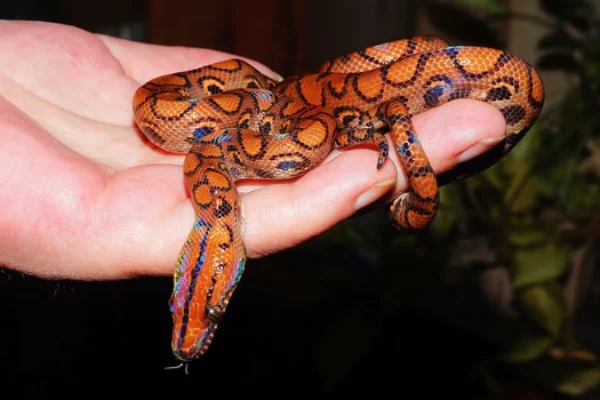
| Scientific Name | Epicrates cenchria |
| Size | 48-72 in |
| Diet | Feed on small rats and mice. |
| Location | Central and South America |
As the name suggests, these come in a variety of colors which captivates reptile enthusiasts and nature lovers alike.
The colors can include a wide array of oranges, reds, yellows, greens, and even purples.
They are amazing swimmers and their habitat consists of humid woodlands and rainforests.
These magnificent reptiles have been known to live for up to 30 years if they are well cared for.
15) San Francisco Garter Snake
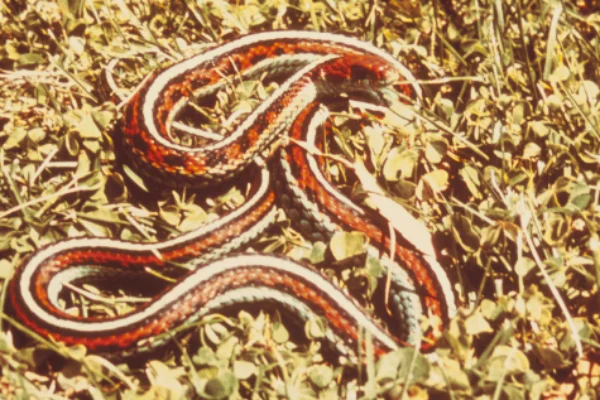
| Scientific Name | Thamnophis sirtalis tetrataenia |
| Size | 18-55 in |
| Diet | They feed extensively on aquatic animals and small amphibians like frogs |
| Location | San Mateo County and Northern Santa Cruz County |
They have a blue-green dorsal body that is exquisitely decorated with red stripes, and sometimes orange and black stripes as well, which gives them their distinctive aesthetic look.
They have comparatively better eyesight than most in their species.
Studies have shown a correlation between the length of their snout and ovarian follicle growth, which increases sexual activity.
However, if a person is bitten, they may experience mild irritation due to the presence of a mildly toxic venom in the saliva of these insects.
16) Indian sand boa
| Scientific Name | Eryx johnii |
| Size | 24-36 in |
| Diet | They commonly feed on small mammals like rats, mice, and small rodents. |
| Location | India, Iran, and Pakistan |
Their body is uniformly colored with a reddish-brown or dull orange-yellow tan appearing throughout.
Non-venomous constrictor named in honor of German naturalist – Christoph Samuel John.
Adapted to burrowing, their heads are wedge-shaped with narrow nostrils and small eyes.
Illegal trade has resulted in an extensive decline in their population.
17) Forest flame snake
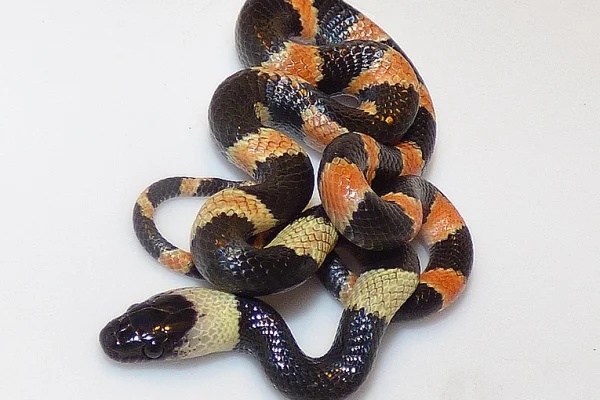
| Scientific Name | Oxyrhopus petolarius |
| Size | 36 in |
| Diet | They feed on lizards, frogs other amphibians, and smaller mammals |
| Location | South America |
Their coloration is variable, ranging from reddish-orange to black rings, with the anterior side of their bodies typically being white or grey. Their backs, however, are always black.
They have poisonous fangs in the back and a highly toxic venom that kills lizards.
18) Aesculapian false coral snake

| Scientific Name | Erythrolamprus aesculapii |
| Size | 16-25 in |
| Diet | Mainly consumes other snakes, including occasionally those that are poisonous. It will on occasion consume lizards, fish, and earthworms for food. |
| Location | South America |
They have the same bright reddish-orange blotch with black borders as the long-nosed snake, which is a striking similarity between the two species.
These snakes, which are only mildly poisonous, get their name from the Greek god of medicine – Aesculapius.
19) False coral snake
| Scientific Name | Oxyrhopus guibei |
| Size | 39-59 in |
| Diet | Their diet consists of rodents, lizards, and other small animals. |
| Location | Central South America |
Like the other snakes in their species, they have orange and black bands running down their body.
These are named for their ability to mimic the coloration of true coral snakes that are venomous as an evolutionary tactic.
The name Guibei is given in honor of French herpetologist Jean Guibe.
20) Albino Corn Snake
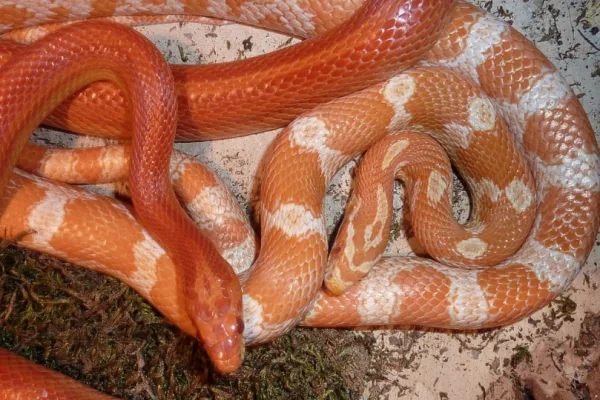
| Scientific Name | Pantherophis guttatus |
| Size | 24-71 in |
| Diet | Known to eat small rodents, some reptiles, and even unprotected bird eggs on occasion. |
| Location | Southeastern United States |
They have markings and distinct patterns running down their bodies that are comparable to those found in their normal counterparts.
Because albinos are more likely to have lighter spots and markings, these animals tend to have an orange coloration that is both vibrant and subdued.
Conclusion
In this article, we have made an effort to compile a comprehensive list of the 20 most stunning orange snakes that can be found in nature as well as the natural environments in which they live.
Although orange snakes are not a common sighting, they can be distinguished by their distinct orange hue. Snakes with red markings frequently appear to transform into various shades of orange, giving them a distinct orange hue.
Only two or three of these are considered to be of the least concern; the majority of them are either endangered or very close to going extinct. It is our responsibility to pay closer attention to the natural world and the environment in which we live.
This article was our small part in spreading awareness and providing information about the stunning orange snake species that can be found in different parts of the world.
Also Read:

Hi everyone, my name is Shawna, and I’ve always been fascinated by the fascinating diversity of flora and fauna that our nature has in it. I am currently studying biotechnology and am particularly interested in animal biotechnology, delving into the intricate processes that define their true nature and uniqueness.
